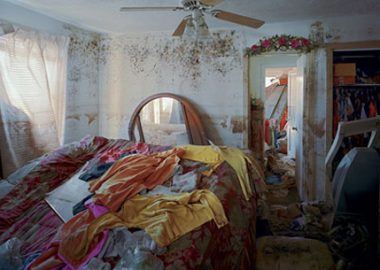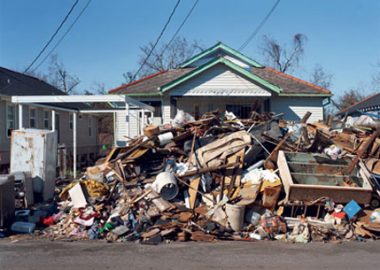By Davy Jones via The Drawbridge
Davy Jones speaks to photographer Robert Polidori about his images of post-hurricane New Orleans

5000 Cartier Avenue
How did this project begin and why did you feel compelled to do it?
I’m a staff photographer at the New Yorker and they initially sent me to New Orleans. Originally, I thought I was going to do a book that was about the receding flood, demolition and reconstruction. My book really only goes about halfway around that cycle because the reconstruction is not going to happen for a long time. Reconstruction follows economics, it may take ten years for the reconstruction to happen.
I felt strongly about so many of these interiors. One can see the fibres of people’s lives that no longer are. Most people lived through the storm, they were either pre- or post-evacuated. The life that they had no longer exists and what you’re looking at in those interiors are sort of indices of a life that’s no longer there. What you’re looking at is a sort of curious mortuary, not of an individual that’s dead, but of a life that’s dead.
The exteriors are indices of what kind of force of nature was able to do this. I mean, it’s hard to just figure out what used to be where.
There’s a large amount of work in the book, how long did the project take and why do it this way?
I was there four times, altogether I was there maybe three months in total. It was shot with 5 x 7 except for the smaller pictures in mosaics, they were shot in digital. The full page images are more emotional whereas the other digital images are more like mug shots because there’s so much of it. As big as the book is, it only represents about 0.001% of the houses and I wanted to get that across. There’s just miles and miles and miles of devastation. The full-page images are concentrating on a certain identity of a house or an interior, whereas those other ones are more street- or avenue-conscious where one is looking more at the collectivity of the dwelling.
Bearing in mind some of your other work, for example Chernobyl, you seem to quite like working in discomfort.
Well, I don’t like working in discomfort. What I’m interested in is what I politely call habitat violation or vulgarly will refer to as room rape. I’m fascinated with interiors because I see them as indices of the Jungian notion of the super ego. You can take a portrait of somebody but you don’t really know all that much about them, but if you look at their interiors you have many more clues as to their personal values.
I try to pick ones that have an historical importance because I think that we are living, historically, in a really important time. I think it’s the end of industrialism, so there’s major changes that are happening. I don’t really make photos that are about the rules of art making. I would say that it’s about the way that we live. My photos have a subject matter and then I try to render that subject matter artistically, so I guess the art part is like an adverb or adjective. I’m interested in the subject of the images. It’s not that I like danger, but I want those kinds of images and sometimes they are difficult to get, it’s just the way it is.
Did you find the edit a difficult process?
No, I like editing. I never studied photography, I studied film-making.
Did it inform you as you went along?
Sort of, by the second trip I knew what I was going after. With a photography book, where you have pictures on the left- and right-hand pages, it’s like a double-screen effect. It’s not like editing for a film where you have a single screen, so it makes a nice edit a little more complicated. Page adjacencies for me have to have correspondences which are both ideal content-wise and they have to be graphically harmonic.
Transferring a project like this from the book to a gallery space can be tricky, how did that work?
At the Met, the edit was done by the curator there. The show at Flowers East is only maybe 25-30% different. Let me say, as far as the prints go, they come off really well. There’s a lot of detail so there’s a lot of things you see in the prints that you don’t see as well in the book.
What do you think makes a conceptual documentary approach different to a photojournalistic approach?
One might be framing – the way that one is looking at a subject. I don’t say I’m not a photojournalist but maybe it’s that most or many photojournalists aren’t that careful – they feel satisfied with pointing in the right direction. Many photojournalists simply did not study or don’t care about the past visual arts that much, so there’s a whole lot of visual grammar that either they ignore or choose to ignore.
What do you look for in pictures?
A good photographer has a recognizable style that’s true, but I’m not just into it for stylistics. I think a picture has to be about something and that something about the subject must be revealed. That’s what I look for.
Who are your points of reference?
I really like the work of Joel Sternfeld. I was influenced by a lot of avant-garde film because this is what I studied. I also really like the work of Michael Snow, who was part of what is known here as the structuralist movement. I would say one of the biggest influences in my life is Bob Dylan because he has a sense of meaning and paradox. A lot of his work is about an inner soul life. I don’t get any deep meanings out of Elvis’s work.
In the 60s the prevalent thing in the art schools here was, “I’m making my art for myself, I’m not doing it for anyone else”. Well, I do it for other people. I was born an immigrant, I emigrated to the US so I’m more looking for a sense of belonging. I think we’re living in a time of major changes and that all these people that are sitting around making art about art-making are a little bit like guys that are twiddling their thumbs while Rome is burning.
I like Rome, because to me Rome means civilization. That’s why I’m not influenced by Andy Warhol. Who cares about his shit? When I was young I thought what a clever and great social commentarian, but then when I met these people I realized there’s no social commentary intent here. I’m looking for more substance, either psychological or historical. If you’re going to spend all your time and money making images it might as well be about something important rather than something dumb. Plus if you want to get an audience why should you make them look at something dumb? I don’t see the wisdom in that.
The documentary process in photography can be exploitative, how do you feel about that?
Well, I don’t have guilt about that. I spent a lot of money shooting a lot of other people’s stuff. I’m not unrespectful. A lot of the pictures of the interiors are like going to a mortuary home or some kind of funeral, it’s like a kind of last rites.

6539 Canal Street

6328 North Miro Street

5325 St Anthony Avenue

1826 Flood Street
